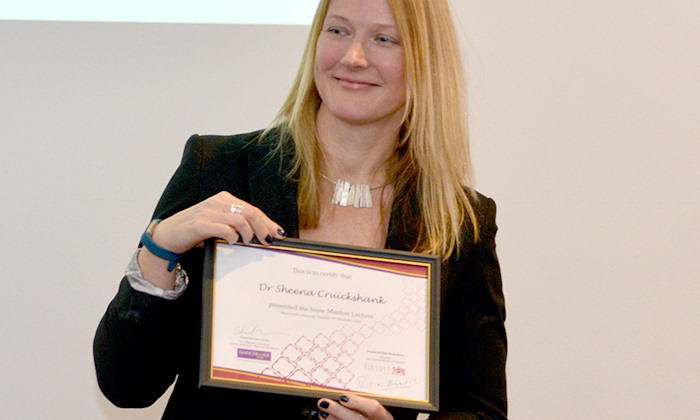Sheena shares her passion for parasites in 2016 Irene Manton Lecture
14 Dec 2016
Dr Sheena Cruickshank was the key speaker at the annual lecture to celebrate women's contributions to the natural sciences, hosted by the University, in collaboration with The Linnean Society and Manchester Museum

Irene Manton was the first female president of the Linnean Society, a British botanist who continued her studies at the University of Manchester, resulting in a PhD.
A varied audience of over 80 attendees came along to the lecture, organised by the Faculty of Biology, Medicine and Health, in collaboration with the Linnean Society and Manchester Museum. It was particularly pleasing to see so many sixth form students amongst the group.
The meeting was chaired by Hema Radhakrishnan, Associate Dean for Social Responsibility, and was joined by Dianne Edwards, President of the Linnean Society, who introduced Irene Manton’s work and the impact that she made on botany.
The key speaker, Dr Sheena Cruickshank from the School of Biological Sciences, talked passionately about her research, which is focused on the body’s immune response to injury or infections such as parasitic worms. Her interactive lecture included animations and 3-D images of these fascinating and (in Sheena’s own words) sometimes "icky" world of parasites.
Comments from the audience included:
- "The talk was fab"
- "Amazing to see research hot off the press"
- "Great to be part of celebrating women in science"
- "Great talk, extremely engaging and easy to follow, great examples used, thanks!"
- "Funny and interactive, really enjoyed the lecture and how it was made relatable to our lives"
Professor Mahesh Nirmalan, Vice Dean for Social Responsibility within the Faculty, said “Biology, health and imaging technology was brought together in this inspirational lecture and the Q&A session – with the participation of primary and secondary school children, confirmed how engaged they were in science. This was an example of science communication at its very best.”
Following the lecture, Dr Cruickshank said “It was a real honour to give the lecture and I really enjoyed the fantastic questions from the audience - hopefully there are some budding biologists in the future!”
The Faculty plans to continue holding this annual event as part of its Community Engagement and Involvement programme contributing to the University’s strategic goal of Social Responsibility.
